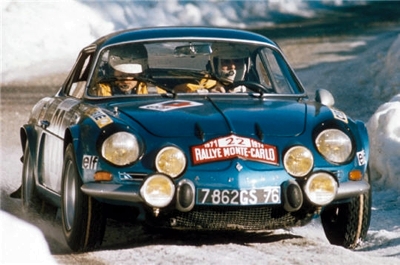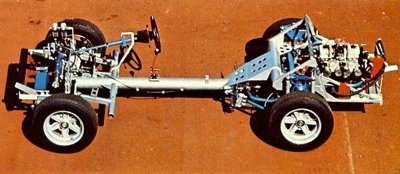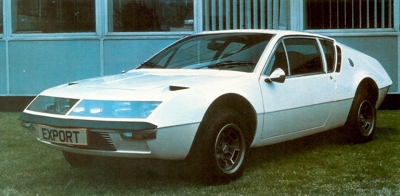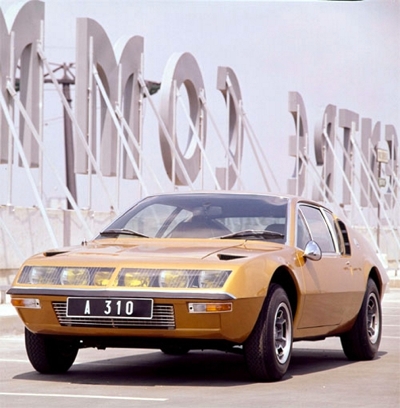|
Apine
|
1955
- 1995 |
Country: |
 |
|
After World War 2 France suffered more than most from a depressed economy, and with a car taxation system which penalised cars with engines over 2.8 liters the great French quality marques like Delage, Delahaye, Bugatti, Hispano-Suiza and Hotchkiss either failed to survive the war or lasted for only a short while afterwards.
Even the cars which temporarily replaced them, like the Facel Vega, soon expired and French drivers with sporting inclinations were forced to buy foreign cars or modify their humble Renaults, Peugeots, Simcas and Citroens.
This situation continued until the mid 1950s, although Gordini struggled on a shoestring budget to build Grand Prix cars in an effort to give some prestige to the car industry of France, but his cars seldom won and seldom even finished. The only mildly sporting cars in production, apart from the Talbot (which was about to die) and the Facel Vega (which was only just getting into its short-lived stride), were the DB and the Alpine.
The DB, made by Deutsch and Bonnet, was powered by a Panhard engine, which hardly endowed it with earth-shattering performance, while the Alpine was powered by a 750cc Renault engine.
Yet, from these extraordinarily humble beginnings rose two marques which were to give France some semblance of respect in world motor racing: the DB eventually became the Matra, which won the World Championship for Jackie Stewart in 1969, and the Alpine turned into the Alpine-Renault which competed in the rally world with so amazing success.
The founder of the Societe des Automobiles Alpine, Jean Redele, was born in Dieppe in 1922, the son of a garage proprietor who ran a Renault agency. He showed great interest in his father's business and took an engineering degree before returning to Dieppe to assist his father.
The war left the business destitute but he began rebuilding the garage in 1946, surviving by repairing pre-war cars, tractors and other agricultural machinery, for there were no new cars to sell. Gradually, the company was put on a firm footing and the still-young Redele's thoughts turned to competition motoring.
The only suitable Renault model in the early 1950s was the 4CV, a tiny 750cc rear engined saloon which carried millions of Frenchmen towards the 1960s. Few would have felt that this tiny machine had any sporting characteristics at all, but Redele modified it considerably, even fitting as-speed gearbox to extract a little more performance. He took part in every possible type of competition event, including rallies, hill climbs and races - and not only local events, as he was addicted to long distance affairs and the 4CV was subjected to the rigours of the Coupe des Alpes and the Mille Miglia.
The Coupe des Alpes, or Alpine Rally as it was also known, was one of the most arduous long distance rallies. The Mille Miglia was the famous 1000 mile race round Italy. Naturally, the little 4CV could hardly be expected to figure among the winners but it was a consistent class winner; in fact Redele won the 750 class of the MilIe Miglia three years running in 1952, 1953 and 1954. It was during this period that the idea for a more sporting version of the 4CV came to Redele and, during 1954 and 1955, work on a sports version progressed.
This was at the garage in Dieppe, where Alpine remained for many decades, although in much grander premises. The car, when it finally appeared in 1955, used virtually all of the running gear from the 4CV, housed in a glass-fibre two-door coupe body which allowed a little room for rear-seat passengers. The name of Alpine was decided upon simply because Redele loved driving his cars on the sinuous facets of the French Alps. The first car, the A106, was given the name Mille Miles, in honour of his class victories in that race.
Sales were low but Redele was able to keep the production side of the business going on the profits of the garage. In 1956, when the Renault Dauphine was announced, the A106 was quickly given the more robust 850cc Dauphine engine, which was soon uprated to 904cc. The A106 soon saw service in competition and in 1956 French driver Maurice Michy won his class in the Mille Miglia with ease. Ironically, Jean Redele drove an ordinary Dauphine saloon in the same race and was not well placed.
In 1957 the A106 was joined by a cabriolet version, called the A108, although apart from the bodywork it was mechanically similar to the A106. In 1959 the range was supplemented by a 'Sport' version of the cabriolet which, although similar in appearance to the A108, really marked the beginning of Alpine as a proper manufacturer: instead of using a crude girder chassis with running gear from Renault, Redele designed his own steel tube chassis on which to hang the Renault units.
 An Alpine A110 in action at the Monte-Carlo Rally.
An Alpine A110 in action at the Monte-Carlo Rally.
 This photo shows the chassis of the Alpine 1300GT.
This photo shows the chassis of the Alpine 1300GT.
 The Alpine A310 Coupe was announced at the Geneva Motor Show in 1971.
The Alpine A310 Coupe was announced at the Geneva Motor Show in 1971.
 The Alpine A310 used a Renault 16TS engine producing 140bhp, with a 5 speed gearbox. The 2 + 2 body featured a distinctive headlight system, with 6 in total all behind a perspex cover.
The Alpine A310 used a Renault 16TS engine producing 140bhp, with a 5 speed gearbox. The 2 + 2 body featured a distinctive headlight system, with 6 in total all behind a perspex cover. |
Yet another model announced in 1959 was the 2+2 coupe which offered small rear seats in a sporting looking bodyshell. In 1961 Redele produced a variant of the A108, the Berlinette Tour de France, a 2+2 coupe, the glass- fibre body of which was developed from that of the stubbier, taller, Sport coupe. It featured a new chassis, with acentral backbone mated to a steel platform, but the running gear was still very much the same as on all the Alpines made since 1955. The front suspension featured double wishbones with coil springs, while at the rear the Renault Dauphine swing axle suspension was used in conjunction with coil springs. Steering was by rack and pinion and braking by discs.
The Renault Dauphine engine was again used, with options up to 956cc, this unit giving a modest 55 bhp at 5500 rpm in road trim. With its engine extending well back behind the rear wheels, combined with swing axle rear suspension, the Alpine seemed to be ill-equipped to provide fast, safe road motoring, yet this model was developed in the ensuing years into a very potent car, one which became unbeatable in certain types of rally. The Berlinette was extensively raced and rallied and although its low power output restricted its chances of outright wins it was a regular class winner.
Home grown competition came Alpine's way in 1962 when Rene Bonnet bought out his partner Deutsch in the DB company, switched from Panhard to Renault power and began to make mid-engined sports cars which were as fast, if not faster, than the Alpine. The Bonnet cars began to appear in long distance races but were soon taken over by Matra, the missile and aerospace company. The appearance of the Bonnet cars inspired Redele to greater efforts and in 1963 he brought out the A110 Berlinette Tour de France, which was much the same as the A108 BerIinette but which had a 998cc version of the Renault four-cylinder engine giving 77 bhp at 5800 rpm. It was also available with a five-speed gearbox as a production option, and an 1108cc competition version of the engine from the new Renault R8 and Caravelle models was made available.
Len Terry's Alpine M63
This engine gave 87 bhp, but the Rene Bonnet mid-engined car was better, with its twin-camshaft version of the engine designed by Amedee Gordini for Renault. This gave 100 bhp in road form and a top speed for the little Djet of 135 mph. However, Alpine was also soon able to use this engine. The first true sports-racer was the M63, which had been designed for Redele by British designer Len Terry. This tiny space-framed car proved to be quite successful in 1963, as was its rebodied successor, the M64, the following year.
With their small Renault-based engines they could hardly hope for more than class wins and good placings, but they ran consistently, especially at Le Mans. The cars were invariably first in the Index of Performance and Index of Energy categories at Le Mans, which were arranged using a formula covering engine size, weight, fuel consumption, etc. Foreign cynics claimed that the formula had been designed specifically for the manufacturers of French small cars.
Ron Tauranac's Alpine F3
The M64 won its class in 1964 at Le Mans, Rheims,
Sebring and the Targa Florio, which was no small achievement. On its Le Mans gearing the M64 was capable of topping 150 mph and it averaged just over 100 mph while winning the class. Alpine also decided to build single seaters in 1964 and Redele again turned to Britain for his designer, this time choosing Ron Tauranac, an Australian who was in the process of taking the Brabham team into Formula 1. He designed a dual-purpose chassis which could be used both in Formula 2 and Formula 3, the F3 car being fitted with a push rod Renault unit and the F2 car having the Gordini tuned R8 twin camshaft variant which gave around 110 bhp at 8500 rpm.
Unfortunately this was well down on what the Cosworth-Ford engine produced and even further down on the high-revving Honda engine used by Jack Brabham so successfully, so that very little success came Alpine's way in F2. In international F3 racing too Alpine were not competitive, even though a few wins came their way on home soil. It soon became obvious that more power would be needed to make a race winner, and since that power was not forthcoming the Alpine soon faded out of single-seater racing, leaving the field wide open to Matra, which began making F3 cars in 1965.
The Alpine sports racing car for 1965, the M65, was very much more aerodynamic than the M64, and it sprouted large tail fins at the rear to aid directional stability on the long Le Mans straight, where the car invariably put in its best efforts. This model could be fitted with a 1300 cc version of the twin-cam motor but, apart from a class win at Rheims, the season was more or less a disaster for Alpine. On the production car side development stagnated, for a great deal of effort had been put into the racing cars, with help (both practical and financial) from Renault. The Berlinette A110, which was introduced in 1963, was to remain in full production for thirteen years, all that time with much the same mechanically, but there was a variety of engine options.
In sports car racing the A210 was introduced for 1966 but this differed mainly in bodywork, as the chassis was still very much the same as the original Len Terry design. This version stayed in production for several years, picking up one or two good placings, such as 9th, 10th, 12th and 13th at Le Mans in 1967 and 9th, 10th and 11th in 1968. In fact, in 1968 an Alpine also finished 8th. This was the A220, which had made its debut towards the end of the previous season.
The Alpine A210 with Gordini V8
Again, its chassis was much the same as the A210s, but it was powered by a new Gordini-devised V8 engine which was in effect a pair of 1500cc Gordini-Renault engines on a common crankcase. The block was in cast iron and the heads were in aluminum but it was not powerful enough, even on its debut, to provide a race winner and, although it was developed to give around 300 bhp, its rivals were way ahead of that output figure.
Any placings which Alpine achieved with the A220, such as the 8th at Le Mans in 1968 and 6th at Monza in 1969, were gained solely on reliability. Redele received a blow in 1967, as the French Government had decided that France should take part in Formula 1 racing for prestige purposes. Matra, which was winning F3 races everywhere, put up a proposal to the Government, which immediately offered assistance to the tune of nearly 1 million US dollars in order to build a Formula 1 car.
Redele had hoped for some Government money to develop his own Formula 1 car, but he was by-passed, and Matra went on to win the World Championship in 1969, although they had to use a British-made Cosworth-Ford engine to achieve the victory. However, Renault continued to back Redele and he continued his work with the sports-prototype cars and a revised Formula 3 car, which began to show signs of more success than its predecessors, partly because the brilliant young Francois Cevert was at the wheel.
Switching from Single Seater Racing to Rally
Redele also built single seaters for Formula France, the engines of which were also provided by Renault. In 1969 Redele decided to withdraw from racing, as he was completely overshadowed in France by Matra, and began to develop the faithful A110 road car for rallying. By now it was available with the engine from the R16 saloon, and in the Berlinette 1600S form it gave 138bhp at 6000 rpm, which endowed the little coupe with a top speed of over 130 mph.
A Clean Sweep of the Coupe des Alpes
With some rapid development the A110 suddenly proved itself to be an extremely agile rally car. Its rearward weight bias gave it ideal oversteering characteristics and the drivers found that they could fling it round the rock strewn roads and ice-bound Alps at incredible speeds on many international rallies. The highlight of 1969 was a 1, 2, 3 clean sweep of the Coupe des Alpes on home ground and a promising third place in the Monte Carlo Rally.
A Clean Sweep of the 1971 Monte Carlo
They followed up in 1970 with another third place in the Monte and three victories: in the Italian Rally, the very tough Acropolis rally in Greece and the Tour of Corsica - a thinly disguised road race round the island. Alpine driver Jean-Claude Andruet became European Rally Champion in 1970. On this rising tide of success Renault announced that Alpine would be responsible for the entire Regie Renault competition programme' and the team celebrated with an overwhelming 1, 2, 3 victory in the 1971 Monte Carlo rally, a victory which was sweetened by new-found sponsorship from the Government-owned Elf petrol company.
The Monte winner, Sweden's Ove Andersson, went on to win the Italian Rally, the Austrian Alpine rally and the Acropolis rally, while Bernard Darniche won the Coupe des Alpes. Andersson's victories gave Alpine the 1971 International Rally Championship by a huge margin. French driver Jean-Pierre Nicholas won the 1971 TAP rally, the Geneva Rally and the Lyons-Charbonnieres rally to add to Alpine's massive score of victories. The company also made another return to single-seater racing, and this time, with the same amount of power as the other teams, and an efficient (if rather ugly) hump-backed body, the Formula 3 car ran as well as anything else in its class and a number of good wins were chalked up.
At the Geneva Show in 1971 Alpine introduced their first really new car for eight years, the A310. This impressive looking 2 + 2 fastback still stuck to the Alpine formula, with the Renault engine hung well behind the rear axle, but the suspension was much modified from the A110 design. The power unit offered as standard for the A310 was the R16TS unit modified to give 140 bhp at 6250 rpm, which gives a top speed of 130 mph. The A310 was not aimed at the competition market and it was luxuriously trimmed and fitted out for road use.
Ground Hog Day - Alpine Repeat their Monte Clean Sweep
Production was slow to get under way but reached around 3000 a year by 1974. Although a number of rally victories, such as the Lyons-Charbonnieres, the Neige et Glace and the Olympic, were achieved in 1972 by Alpines, the big ones, except for the Tour de Corse won by Andruet, eluded them. However, 1973 started in impeccable fashion, the Alpines repeating their 1971 1, 2, 3 Monte Carlo Rally victory led by Andruet and went on to win the 1973 World Rally Championship.
The following year saw a decline in Alpine rally fortunes and they could manage no better then tenth place in the championship. Nevertheless, the company still enjoyed international success, with Frenchman Alain Serpaggi driving a Renault V6-engined Alpine to victory in the European 2-liter sports-car championship. By 1975, the sports-car team was no longer completely competitive and achieved only third place in that year's World Championship for Makes competition with their turbocharged Alpine-Renault.
In 1976 the A310 was restyled by Robert Opron and fitted with the more powerful and newly-developed V6 PRV engine. The 2.6 L motor was modified by Alpine with a four-speed manual gearbox. Later they would use a Five-speed manual gearbox and with the group 4 model get a higher tune with more cubic capacity and 3 twin barrel Weber carburetors.In 1976, Alpine, with Renault, embarked on an ambitious project to build a turbochatged Formula One car - but development of the turbocharged unit was swithced to another project, the A442B.
The Alpine A310
In 1978 the investment was to pay off with the A442B taking out that years Le Mans. Alpine had been the first company to run in and win an international rally with a turbo car as far back as 1972 when Jean-Luc Thérier took a specially modified A110 to victory on the Critérium des Cévennes. Throughtout the 1980s Alpine Renault continued to develop their range of models - the A310 was the next modern interpretation of the A110, a sports car with a rear-mounted engine initially powered by a four cylinder 1.6 liter sourced Renault 17TS/Gordini engine. After the A310 Alpine transformed into the new Alpine GTA range produced from plastic and polyester components, commencing with normally aspirated PRV V6 engines.
In 1985 the V6 Turbo was introduced to complete the range. This car was faster and more powerful than the normally aspirated version. In 1986 polyester parts were cut for the first time by robot using a high pressure (3500 bar) water jet, 0.15 mm (0.01 in) in diameter at three times the speed of sound. In the same year the American specification V6 Turbo was developed. In 1987 fitment of anti-pollution systems allowed the V6 Turbo to be distributed to Switzerland, Germany, Austria and the Netherlands. 1989 saw the launch of the limited edition GTA Mille Miles to celebrate the 35th anniversary of Alpine. Production was limited to 100 cars, all fitted with ABS braking, polished wheels, special leather interior and paintwork. This version was not available in Right Hand Drive (RHD).
The Alpine GTA Le Mans
1990 saw the launch of the special edition wide bodied GTA Le Mans. The car wore polyester wheel arch extensions with a one piece front. Wheels were 3 piece BBS style produced by ACT, 8x16" front & 10x17" rear. Otherwise identical mechanically to the V6 Turbo, the engine was fitted with a catalytic converter and power was reduced to 185 bhp (138 kW). This model was available in the UK and RHD versions carried a numbered plaque on the dashboard. The Le Mans is the most collectable and valuable GTA derivative, since only 325 were made (299 LHD and 26 RHD). These were available from Renault dealers in the UK and the country's motoring press are belatedly recognising the GTA series as the 'great unsung supercar of the 1980s'
The Alpine A610 was launched in 1991. It was re-styled inside and out but was still recognisable as a GTA derivative. The chassis structure was extensively reworked but the central box principal remained the same. The front was completely re-designed the interior was also greatly improved. Air-conditioning and power steering were fitted as standard. The total production run for A610s derivatives was 818 vehicles 67 RHD and 751 LHD. After production of the A610 ended, the Alpine factory in Dieppe produced the Renault Sport Spider and a new era was to begin.
The last Alpine, an A610, rolled off the Dieppe line late in 1994, Renault abandoning the Alpine name. This was always a problem in the UK market. Alpines could not be sold in the UK under their own name because Sunbeam owned the trade mark (because of the mid-50s Sunbeam Alpine Mk I). In the 1970s, for example Dieppe were building modified Renault R5s for the world wide market. The rest of the world knew them as R5 Alpines but in the UK they had to be renamed to R5 Gordini. Strangely enough with the numerous company takeovers that have occurred, it is another French company, PSA (Peugot/Talbot/Citroën) who now own the British Alpine trademark.
The Alpine factory in Dieppe continues to expand; in the 1980s they built the special R5 Turbo cars, following the rear engined formula they have always used. They built all Clio Williams and RenaultSport Spiders. The factory proudly put its Alpine badges on the built early batches of the mid engined Clio series one Clio V6. The Clio Series 2 was also assembled there with more recent RenaultSport Clio 172 and RenaultSport Clio 182s.
